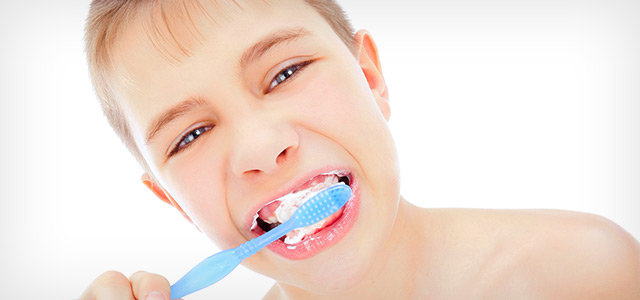
Back’n’forth, back’n’forth – scrubba’ scrubba’ scrubba! Get those teeth clean!
However, if your child’s brushing more resembles a lumberjack sawing trees in half than it does a gentle massage, they might be in for a lifetime of sensitive teeth, bonding treatments and receding gums.
With this in mind, here are four tips for avoiding enamel loss when brushing. And the best part is, even parents can benefit from these tips as well!
Brushing too frequently
Taking to the toothbrush three times a day is ideal, particularly if you do it after meals. More than three brushing sessions, though, and your child might end up doing more harm than good.
Teenagers might have a desire to clean more frequently if they wear braces, but it’s really not necessary.
If your teen snacks frequently, or uses sport beverages, encourage them to rinse their mouths with water afterwards instead of constantly brushing throughout the day.
Brushing too vigorously
The number one self-inflicted cause of worn enamel is brushing too hard.
In a race to get through the boredom of brushing their teeth, many children pick up the bad habit of brushing with a back 'n' forth, saw-like motion. It also sounds effective, and if you’ve ever seen a character brush their teeth in a cartoon, or in the movies, that’s how it’s done – so you can’t blame ‘em, really.
In actuality, the continual friction along the gumline wears away not only the enamel, but also gum tissue, and that’s not good.
If you spy your youngsters brushing this way, correct the behavior by illustrating the correct way, which is to brush gently and in a circular motion, aiming the head of the toothbrush at a 45 degree angle toward the base of the gums.
Using an ill-fitting toothbrush
If your child is using a toothbrush with bristles just a hair shorter than the ones on their hairbrush, a change to a smaller one is probably in order. Our toothbrush use should always fit our mouths, and for the growing mouths of children, that brush size is going to change until they reach adulthood.
Try out different sizes. Smaller is often better. And, by all means, ask your dentist the next time you’re in for a visit. They’ll no doubt have a great suggestion that will be a perfect match to the size of your child’s mouth and teeth!
Using a toothbrush with bristles that are too stiff
Just as the dimension of a toothbrush matters, so does the stiffness of the bristles. Bristles that are too firm can be damaging to enamel and gum tissue in much the same way as brushing too vigorously.
This is why most dentists will recommend either soft or extra-soft bristles on a toothbrush. It’s the technique (see tip No. 2) that really matters, not the force of the brushing, nor the firmness of the bristles.
Again, if you’re not sure, ask your dentist for advice specific to your child!
Saving your child’s tooth enamel from slowly disappearing from their teeth is very simple to avoid, and with the above tips you pretty much have all you need to keep them on the right path.
